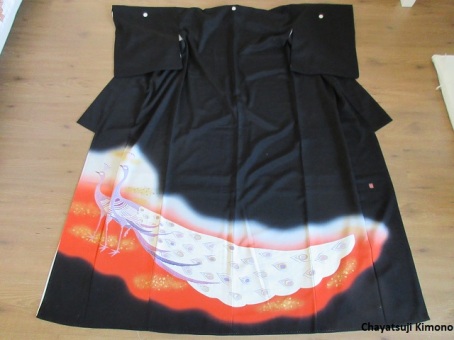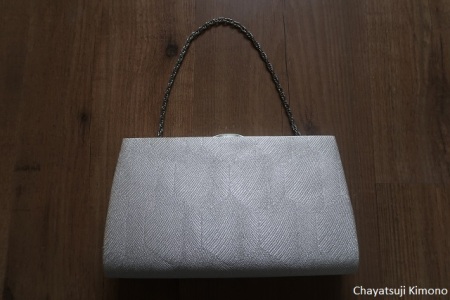

Traditionally worn by the mother of the bride as well as the groom, they are of the highest formality for a married woman. Back in the day, the bride would wear a black crested furisode during her wedding and afterwards, the sleeves would be cut off to be transformed into a kurotomesode, allowing the same kimono to be worn again for a future happy occasion.
Tomesode, in general, are characterized by the lack of design on the top part of the kimono but therefore having a very lavish design on the bottom, often including gold dust and gold thread (couching) and embroidery. The design is often made up of lucky and/or auspicious plants, flowers, animals and objects.
These days, not a lot of Kurotomesode are worn outside of weddings so there have been initiatives to get people to wear them more. Kurotome Night is one of those events (Kurotome Night Tokyo Show link)

Kimono: Kurotomesode
A kimono with a black base that has a colourful, beautifully decorated skirt. Most Kurotomesode are made out of silk fabrics like rinzu (satin weave), kinsha (light crepe) and chirimen (full crepe fabric) but more and more Kurotomesode made out of synthetic fabric are being worn as well. Rentals are more likely to have synthetic pieces as they are easier to maintain.
If you have had the pleasure of holding a kurotomesode in your hands, you may notice that it has an extra lining at the skirt, back of the sleeves, cuffs and collar. This stems from back in the olden days where a full layer was worn in between the nagajuban and actual kurotomesode (irotome too). This practise has since stopped but instead came the hiyoku or extra lining. With nearly every kurotomesode this hiyoku is white. Older Kurotomesode may not have this and instead one should add a white date’eri to give the same look.
Kurotomesode always have 5 kamon, no exceptions. If it has only 3 then it’s likely to be a Houmongi rather than a kurotomesode (or in very rare cases, a stage piece).


Obi: This one is a bit tricky. By tradition you’re required to wear fukuro obi that is fully silver or gold, maybe with a hint of other colour if the thread is metallic. The thing is, when I look up “Kurotomesode” in kanji on Instagram, I see tons of people wearing obi that do have gold/silver as the background colour but they’re hardly fully silver or gold. Some wear an obi that is nearly white! I’m not talking about people who wear their kurotomesode in a modern setting or out of traditional style but at weddings etc.
I’ve worn my orange butterfly obi with my Kurotomesode for a few years before I got myself an all-gold obi due to the design being very orange in colour. (Pic: Click here! )
My personal opinion? If you can, stick to fully silver or gold but depending on what your Kurotomesode looks like in terms of its design, you can pick an obi that has other colour in it too.
Aside from fukuro obi, you can also wear maru obi. A type of obi that isn’t as common today as it was 100 years ago before Fukuro obi were invented (1920’s). Back then these were the most formal obi with their fully brocaded front and back. Mind you, they’re almost twice as heavy as fukuro obi and difficult to tie. It’s up to you!


Obiage: White obiage with lots of shibori (full or with a blank part in the middle) is your best choice. The obiage may have some golden or silver decoration although gold seems to be more common.

Obijime: Are you ready for the number of possibilities? Oh boy. It comes down to choosing between flat or round obijime but for the colours, you can pick between white+silver, white+gold, gold+silver, plain gold or plain silver, or a combination of all three. There are many designs available within these colour schemes so pick whatever tickles your fancy. These obijime are just a fraction of what can be found out there. Some flat obijime can have a seasonal design,
I do need to mention that the presence of the fishbone-weave is something you would want to include as this weave is considered formal. So even if your obijime is white with only a little silver or gold, it can definitely be worn with both Iro- and Kurotomesode.
When it comes to flat vs round, flat is always more formal. I’m still looking for a true answer as to why, please let me know if you see something about this topic, I would like to include it into my posts.
I have seen marukuge being worn with kurotomesode as well but less, so I’d say you could wear them too if you want.
Something that I should mention, sometimes obijime for kurotomesode come with this little ornament attached. I’ve seen mostly turtle ones. They are purely decorative and can be taken off if you wish. None of my obijime have this but I’ve seen them online



Nagajuban: I explained in the Irotomesode entry that with 5 kamon, more often than not, the rules for kurotomesode apply due to the high number of kamon. The nagajuban would need to be white, preferably made out of rinzu or satin silk. I must say that the number of synthetic juban is increasing so it’s okay if you only have a white synthetic juban.
The han’eri should be fully white, no embroidery or something similar. If possible, the han’eri needs to be made from shioze or chirimen fabric.

Hadajuban/susoyoke: As always, these should be white.

Tabi: For this formality it’s crucial that the tabi are fully white with either 4 or 5 kohaze.

Footwear: Zori made out of brocade with a high heel are your best choice for wearing with Kurotomesode. Colour-wise, they should be either white, silver, gold or a combination of one (or multiple) of these 3. The more gold or silver, the better suited they are. The hanao and base of the zori need to be made out of the same material.



Fan: Black fans with gold and silver paper are used with Kurotomesode. They sit on the side, tucked into your obi. While with Irotomesode you had a choice between black or white, with Kurotomesode only black is worn.

Bag: Just like the zori. Bags for Kurotomesode are often made out of brocade fabric. Bags that are in a gold or silver colour (predominantly) are a good choice to wear with your Kurotomesode.
(Bag on loan by C van Alphen)
Just like in at the end of the last few entries of my Formality series I want to address that the book that I got this info out of is very hardcore traditional. Most of us don’t get to go to an event where the formality is so strictly adhered to.
Have fun with your ensemble and make it YOU. Especially if you want to wear furisode because you feel like it. Know when to adhere to the rules but walk your own path otherwise ^^
All the info for this series comes from this book:
“Kimono no Kihon. Kitsuke to Obimusubi”.
ISBN: 9784072623329
Thank you so much for reading, this was the last blogpost of (at least) the female series of formalities that you will be likely to find. I truly hope that it has brought some value and hopefully you were able to learn a few new things along the way!
Love,
Youandi
Chayatsuji Kimono
One thought on “Formality Series: Kurotomesode”